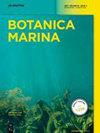Kallymeniopsis恢复和Crossocarpaceae家族合并到Kallymeniaceae(红藻门)的证据
IF 1.4
4区 生物学
Q2 MARINE & FRESHWATER BIOLOGY
引用次数: 0
摘要
摘要我们提出了一个基于核(大亚基核糖体RNA基因的短片段,1150个碱基对)、叶绿体(核酮糖-1,5-二磷酸羧化酶/加氧酶大亚基)和线粒体(细胞色素氧化酶亚基1的5′区)基因的三基因系统发育,巨齿目中的栗白令藻和紫荆花。Perestenko将这些物种归入十字花科,这一提议没有得到大多数藻类学家的支持。该项目的目标是解决这三个物种的分类学地位,并回答这样一个问题:十字花科是一个单独的科吗?串联的多基因系统发育和单个基因树表明,这些藻类在Kallymeniaceae科中嵌套很深;疣状K.verrucosa和lamuticus与目前被称为赤藓属的物种关系最为密切,而栗状B.castanea是最近建立的ruprechtiana Commanderella的姐妹。考虑到不同物种的形态、营养和生殖解剖数据,我们建议用三个物种恢复Kallymeniopsis属,并将Crossocarpus保留为一个单独的属。白令藻属是一个单独的单型属。本文章由计算机程序翻译,如有差异,请以英文原文为准。
Evidence for the reinstatement of Kallymeniopsis and the merger of the family Crossocarpaceae within the family Kallymeniaceae (Rhodophyta)
Abstract We present a three-gene phylogeny, based on nuclear (short fragment of large subunit ribosomal RNA gene, 1150 base pairs), chloroplast (ribulose-1,5-bisphosphate carboxylase/oxygenase large subunit) and mitochondrial (5′ region of the cytochrome oxidase subunit 1) genes, to determine the position of three species, Kallymeniopsis verrucosa, Beringia castanea and Crossocarpus lamuticus in the Gigartinales. These species were placed by Perestenko in the family Crossocarpaceae, a proposal that was not supported by most phycologists. The goal of this project was to resolve the taxonomic position of these three species and answer the question: Is the Crossocarpaceae a separate family? The concatenated multi-gene phylogeny and the individual gene trees show that these algae nest deeply within the family Kallymeniaceae; K. verrucosa and C. lamuticus are most closely related to species referred currently to the genus Erythrophyllum, whereas B. castanea is sister to the recently established Commanderella ruprechtiana. Taking into account the data on morphology, vegetative and reproductive anatomy of different species, we propose to revive the genus Kallymeniopsis with three species and to retain Crossocarpus as a separate genus. Beringia is a separate monotypic genus.
求助全文
通过发布文献求助,成功后即可免费获取论文全文。
去求助
来源期刊

Botanica Marina
生物-海洋与淡水生物学
CiteScore
4.10
自引率
4.50%
发文量
43
期刊介绍:
Botanica Marina publishes high-quality contributions from all of the disciplines of marine botany at all levels of biological organisation from subcellular to ecosystem: chemistry and applications, genomics, physiology and ecology, phylogeny and biogeography. Research involving global or interdisciplinary interest is especially welcome. Applied science papers are appreciated, particularly when they illustrate the application of emerging conceptual issues or promote developing technologies. The journal invites state-of-the art reviews dealing with recent developments in marine botany.
 求助内容:
求助内容: 应助结果提醒方式:
应助结果提醒方式:


